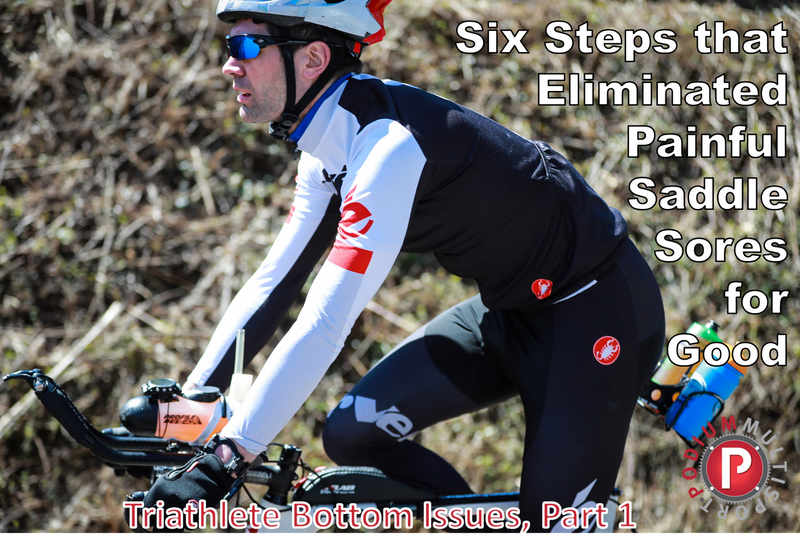Part of a multi-part series of common below-the-belt issues plaguing multi-sport athletes.

It’s November 2019, the day after Ironman Florida, where I hit a huge PR of 9:31 and am making progress toward my three-year goal of a Kona qualification spot. Instead of celebrating, however, I can barely move. Amazingly, my muscles are all good to go. They don’t hurt much, but instead, I have a golf-ball size saddle sore on my inner thigh that feels like a knife stab with every movement I make.
It’s almost embarrassing explaining to the urgent care doctors that I’m not actually injured from the race, but rather from a lack of self-care that let a small problem run away.
Where did I go wrong – and how could I fix it?
Some people are naturally gifted to rarely be bothered by saddle sores. I am not one of those people. Saddle sores have been an unwelcome, nearly constant companion for many years.
Until recently.
After saddles sores sidelined me, I got serious about solving them. Below are the six steps that finally helped me crack the code of a sore-free tooshie:
1. Don’t use petroleum jelly (like Vaseline); use a high-quality chamois cream instead.
As a chamois cream lubricant, Petroleum Jelly is cheap. Some people love it, but it tends to keep heat in rather than release it. Heat and friction are your enemy with saddle sores. High-quality products aren’t petroleum based, and are solely designed to reduce friction and heat. My current favorite is Enzo's Button Hole Chamois Cream, which I can’t recommend enough. Chamois cream is expensive, but after my $350 doctor bill at Urgent Care to take care of my saddle sore – it’s a bargain. In addition, it lasts way longer than I thought it would. Pro tip – put a layer on your chamois the night before and dry overnight, and then add another layer to the chamois right before you put on your shorts. Don’t apply to your body directly.
2. Upgrade your saddle to eliminate rubbing.
The low-end bike saddle I was riding indoors for hours wasn’t meant for me. It rubbed the wrong places, creating friction and saddle sores. When I switched over to my ISM saddle, life got so much better. Find a cycling shop (like all3sports) that will let you try a bunch of different saddles and pick one that you can ride all day on. Increased comfort and no irregular rubbing equals less saddle sores.

3. Ventilate your saddle when riding indoors.
I have a Zwift addiction and spend excessive amounts of time riding indoors. I love the fan blowing in my face, but adding a second fan pointing directly at my saddle was a big improvement. Eliminating moisture and heat within your shorts means less friction and heat causing sores. You don’t need to splurge on a Wahoo Headwind just for your saddle - any high-powered fan will work – but of course, you could.
4. Change Clothes Often, and keep them clean.
Wearing a dirty kit for hours on end creates the ideal conditions for saddle sores. When bacteria from your unmentionable body parts mixes in with all of your sweat, and then hangs out on your clothes for hours on end, irritations develop. Those irritations grow, become infected, and turn into saddle sores. To combat this, switch out your shorts frequently. Doing an epic 4-hour trainer sessions indoors? Definitely consider switching kits halfway through. Doing a long ride outdoors? Wear other clothes until right before you mount your bike, and have clothes in your car to change into right after the ride. Minimizing the time spent in your wet kit will minimize the opportunities for the bacteria to do its damage.
5. When saddle sores come, stay off the saddle.
Despite my best efforts, sores will still occasionally pop up – although very rare with the above precautions. When they do come, however, it’s time to take some time off of the bike and let the sore go away before clocking more miles. Do you remember that golf-ball size sore I mentioned that put me out of commission after Ironman Florida? That happened because I already had a saddle sore before the race started, and the five-hour bike ride aggravated it enough for it to become a real problem two days later. Taking some days completely off the bike weeks before the race, though, would have eliminated the saddle sore before I stepped foot in Panama City.
6. When you shave your legs, wash with an antimicrobial soap.
This is a tip from my doctor, since post-shaving opens more opportunities for bacteria to make it through your skin. After shaving your legs (to be super aero, of course), wash them thoroughly with an antimicrobial soap such as Hibiclens. These soaps are what doctors use before surgery, so they do their job well (and make your skin tingle a bit). You don’t need to use the soap regularly, just a good scrub right after you shave. Maybe after a really long indoor trainer sessions as well.
With those six steps, I’ve eliminated saddles sores – even while logging more time in the saddle than ever before. Of course, this has all the normal disclaimers that I’m not a doctor – and you should consult a doctor for any type of medical problem (I sure talked to mine a few times about this issue). These six steps, however, should get you started on keeping your nether regions irritation free. Let me know if you have other good advice to share and if any of the above works for you.
Post provided by:
Alex Fuller is a father of three, professional marketer, and captain of the all3sports and podium multisport race teams. He’s on a quest to qualify for Kona by 2022. He’s on Zwift way too much, likes to eat pies for training fuel when he can, and can do some damage at a Sweet Tomatoes salad bar buffet.


0 comments